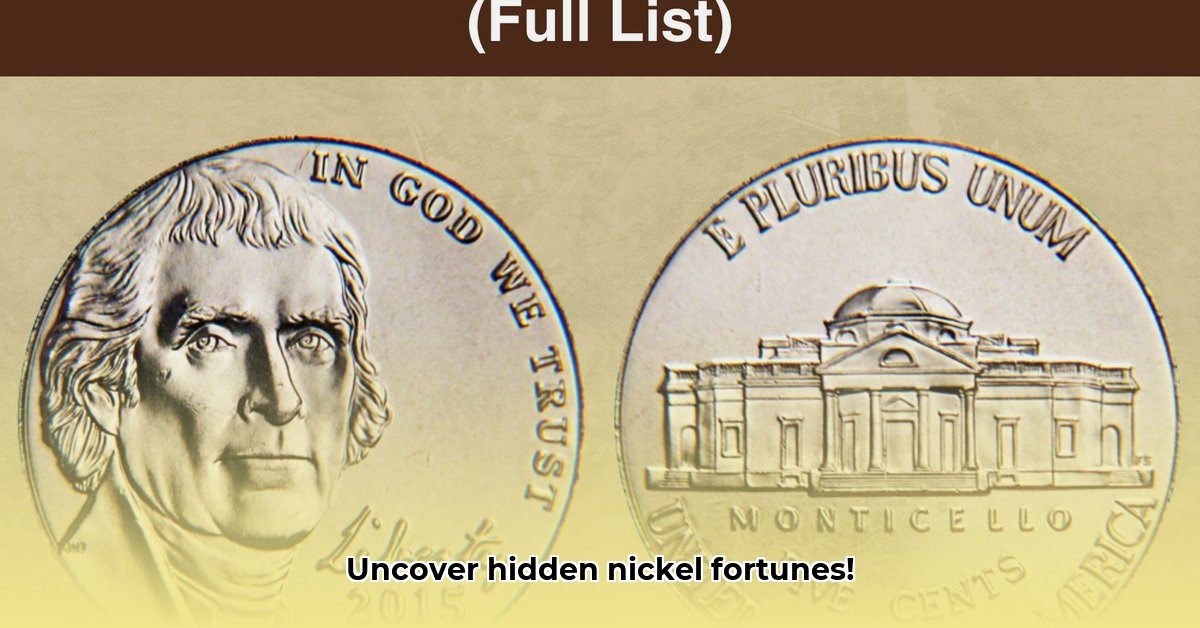
2015 Jefferson Nickel: Unveiling Hidden Value
The seemingly unremarkable 2015 Jefferson nickel holds surprising potential for collectors. While millions were minted, certain errors and exceptional condition can dramatically increase their worth. This guide will equip you with the knowledge to identify valuable specimens and navigate the world of numismatic appraisal.
Understanding the 2015 Nickel Landscape
Approximately 847 million 2015 Jefferson nickels were produced. This high mintage makes finding rare errors a challenge, akin to discovering a needle in a haystack. However, this massive production also increases the probability of encountering minting anomalies, transforming ordinary coins into valuable collectibles.
Did you know? The sheer volume of 2015 nickels minted increases the odds of finding rare error coins, even though most remain commonplace.
Identifying Valuable Minting Errors
Minting errors, often subtle imperfections, significantly impact a nickel's value. Common errors, such as doubled dies (where the image is slightly blurry or doubled due to an imperfect strike), offer modest value increases. However, rarer errors like rotated dies (a slightly turned image) or die clashes (marks from two dies colliding) can lead to substantial price jumps.
"A seemingly insignificant detail can transform an ordinary nickel into a significant collectible," explains Dr. Amelia Hernandez, Numismatic Historian at the American Numismatic Association.
Here's a breakdown of error types and their potential value impact:
| Error Type | Rarity | Potential Value Increase |
|---|---|---|
| Doubled Die | Fairly Common | Small to Moderate |
| Die Chip | Somewhat Rare | Moderate to Substantial |
| Rotated Die | Rare | Substantial to High |
| Die Clash | Very Rare | High to Very High |
| Lamination Error | Extremely Rare | Very High |
| Broadstrike | Extremely Rare | Very High |
| Full Steps (Reverse) | Rare | Substantial to High |
Note: These are estimates; actual value depends on condition and grading.
Condition: A Critical Factor in Valuation
A coin's condition critically influences its value. A pristine, uncirculated (MS) nickel, exhibiting minimal wear, fetches far more than a well-worn example. Professional grading services, such as PCGS and NGC, use numerical scales to assess condition, providing an objective valuation basis.
Determining Value: A Step-by-Step Guide
- Identify Potential Errors: Carefully inspect your nickel for anomalies like those listed above. Use high-quality magnification if needed.
- Assess Condition: Determine the coin's condition using established grading standards. Refer to resources like the Sheldon Scale for guidance.
- Research Comparable Sales: Search online auction databases (e.g., Heritage Auctions, Stack's Bowers Galleries) for similar error coins to establish a price range.
- Seek Professional Grading: For potentially high-value coins, consider professional grading from PCGS or NGC; this adds significant credibility and market value.
- Consult Experts: Seek advice from experienced numismatists or coin dealers for accurate valuation, especially for unique errors.
Pro Tip: Always handle your coins with care to maintain their condition and prevent any damage.
Rarity and Market Demand: Key Value Drivers
Rarity significantly drives a coin's value. While common errors yield only slight price increases, exceedingly rare errors, such as lamination errors or broadstrikes, can command exceptionally high prices. The mint mark (D or P) might also play a minor role though usually insignificant compared to error types and condition. Precise mintage figures for error coins are generally unavailable, adding to their allure.
Risk Mitigation and Best Practices
Accurate error identification is paramount. Misidentifying an error or damaging a rare coin can lead to significant financial losses. Professional authentication offers protection against misidentification.
Remember: Thorough research, careful handling, and professional advice are vital when assessing the value of a potentially valuable 2015 Jefferson nickel. With patience and careful attention, you could uncover a hidden numismatic treasure.